 The idea for a post entitled Organised Chaos arose when somebody asked me a question a few days ago about how I organise my research when I’m writing a new book. I gave, what was for me, quite a sensible answer. Thinking about it afterwards, I realised that I actually do have a system for this. Many other areas in my life bumble along without much of a plan, but when it comes to writing, I’ve learned what works and I stick to it.
The idea for a post entitled Organised Chaos arose when somebody asked me a question a few days ago about how I organise my research when I’m writing a new book. I gave, what was for me, quite a sensible answer. Thinking about it afterwards, I realised that I actually do have a system for this. Many other areas in my life bumble along without much of a plan, but when it comes to writing, I’ve learned what works and I stick to it.

I’m not sure if my system would work for anybody else, but I know that I quite like reading other people’s ideas about organisation, so I thought I’d share the tools I use, in case any of them come in handy for other people. At the very least, you can all have a good laugh at them.
My writing life is very complicated, and every time it threatens to get easier, I find new ways to complicate it further. I’ve published eleven historical novels so far. The earliest two were standalone books but all of the others are linked in some way, although I’ve written them at different times and they are all set at different points of my timeline. So, the Peninsular War Saga begins in 1802 and I’ve published five books, taking me to the end of 1812 and I’m now working on book six. The Manxman series has two books so far and begins in 1806 with the second one taking us into 1810. The two Regency romances are set in 1816 and 1818. In addition, I’ve written eight short stories, all of which are linked to the main books and run from around 1809 through to Waterloo in 1815.
Characters move regularly between the different series. Because I had already published the first four Peninsular books and the two Regencies before I started the Manxman series, I’m not writing the books consecutively. This means that I need to constantly be aware of what my characters do or don’t already know and whom they might have met at a different part of the timeline. I’m time hopping every time I start a new book, which means I need to keep very good records of my characters, even the minor ones. Before I had set up a good system, I discovered during editing that several soldiers who died at Assaye or Talavera were up and fighting again at Bussaco, it was like an episode of the Walking Dead.
A good example of the challenge of this is Giles Fenwick. I first wrote about Giles in one of the Regency romances, where in true romantic hero style, he is a cynical war veteran, emotionally shut down and struggling with what we would call PTSD today. He’s also an Earl. There is a brief mention of his wartime service, where he spent part of his time as an exploring officer.
I then decided to use him in a short story set during the war, and also to introduce him as a minor character into the Peninsular War Saga. From there, I was writing about Walcheren in the second Manxman book and realised that I’d mentioned somewhere that Giles had been there, so introduced him as one of my main characters. Now I’ve moved back to the Peninsula, I’ve given him a bigger role there, but need to remember that Walcheren, although it was the last book I wrote, was four years ago for Giles. Is anybody else confused yet?
I use several tools to keep on top of my characters and my research.
Character List Spreadsheet
This one speaks for itself, really. I use Excel and when I’m editing, I check every single character against this list and add any new information. It has columns for all the basic information such as name, age, physical appearance if I’ve mentioned it, family relationships etc. Then there is a notes column where I can not any significant role the character has played in the book. I don’t use this much for the main characters, since I know what they’ve been up to, but it’s useful to remember, for example, that Private Thompson sometimes acted as orderly and valet to Colonel Wheeler, because it means I’ll be consistent about that. A very important column is headed ‘Death’ and I record the date and how they died. This avoids any zombie resurrections, which is always what we want. I keep a single list for all the books, since the characters move between them.
Book Folder
For each book I’ve written or am about to write, I create a book folder. Everything associated with this book, is stored in the one place, including the book itself, the blurb, the online source folder, book covers, pictures I might like to use on the web page for the book and an ideas folder.
Online Source Folder
In the early days, I used to bookmark really useful sources which are available online, but I found that I was losing track of what I’d found. I might remember reading something about promotion without purchase, but couldn’t remember where. These days, I create a new research folder every time I start a new book and keep it in the same place as my Scrivener files, and I’ll store links to good online resources relevant to this book all in the same place, under headings that make sense to me. It saves a lot of time searching online for something I’ve already found.
Ideas Folder
Every book in the series has a provisional title, even those I’ve not yet written. I might change that when I come to write it, in fact my current work in progress has just been changed from an Unrelenting Enmity to An Unmerciful Incursion to reflect the change in emphasis of the storyline. This means that if I have a sudden idea while writing one book, that I might like to use in a future book, I can make some notes and store them in the folder.
Notebook
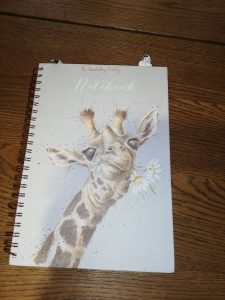 When it comes to the day to day planning for a book, I have to use an old fashioned notebook. Scrivener, which I write with, has the facility to store research and planning notes, and I tried it. I’ve also tried other software such as Aeon, for doing timelines. None of these worked for me. While I’m typing, I much prefer to reach for a book than have endless tabs open on a screen, it just works better.
When it comes to the day to day planning for a book, I have to use an old fashioned notebook. Scrivener, which I write with, has the facility to store research and planning notes, and I tried it. I’ve also tried other software such as Aeon, for doing timelines. None of these worked for me. While I’m typing, I much prefer to reach for a book than have endless tabs open on a screen, it just works better.
It’s also an excuse to use a selection of lovely notebooks. A plain A4 pad would work perfectly well, but of course I don’t use that. As you’ll see from my current notebook, I work best with cute animals, but I’m flexible.
In my notebook, I keep a detailed timeline, almost a diary, of what happened during the period I’m writing about, with quick references to books if I found something particularly useful. I leave a lot of space between dates. Once I’ve got the historical timeline worked out, I’ll go back as I’m writing, and slot in my fictional characters, so that I can weave my own story into the fabric of the historical events. It’s a bit like a diary, and it can change the direction of the book if I find out something interesting while I’m putting this together.
A good example of this is the shipwreck of the Venerable in 1809 off the coast of Walcheren. I first learned about this from the autobiography of Dr McGrigor, who was on the ship, and I slotted it into the timeline, and read about it. It occurred to me that it might be interesting to mention this in the novel, but I wanted to know a bit more about it. McGrigor mentioned two ladies aboard as well as some soldiers wives below decks, and I went through the sources I was using to try to find out more. In the bibliography of a thesis I’d been using, I came across a reference to the diaries and letters of Captain Codrington, whose wife was one of the ladies on the ship. These were available online and were pure gold. I also realised, to my surprise, that it gave me the opportunity to give a much bigger role to the heroine of my previous book as it was a way of bringing her out to join her husband along with Jane Codrington.
In addition, reading the Codrington letters, which were fairly addictive, gave me an idea for a future book in the Manxman series, which immediately went into the ideas folder. The Venerable shipwreck was added into my timeline along with a lot of useful information gleaned from a friend who was doing research on Sir Home Popham and was able to send me photos of the original logs of the ship during this period along with a huge amount of other useful information.
Along with the timeline, I also write a plan in my notebook. Initially this is just an outline, but once I’ve got the storyline clear in my head, I do a detailed chapter by chapter plan. This will probably change a few times, so by the time I’ve finished, I’ll have several of these in the book. I also have a page for each character who has a point of view in the book, so that I can scribble notes about their development, motivation and role in the story.
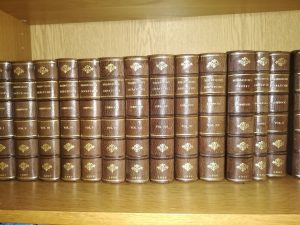 I find maps useful. I own a fabulous Peninsular War Atlas, which is marvellous for all the major battles but I also need to be able to trace the routes my characters take when marching. A lot of the diaries and letters published are great for this, particularly Wellington’s correspondence, since you can see where headquarters was situated on the march by the headings of his letters. I have a beautiful set of his correspondence which my husband bought me for our 25th wedding anniversary and I use them all the time, they’re the joy of my life.
I find maps useful. I own a fabulous Peninsular War Atlas, which is marvellous for all the major battles but I also need to be able to trace the routes my characters take when marching. A lot of the diaries and letters published are great for this, particularly Wellington’s correspondence, since you can see where headquarters was situated on the march by the headings of his letters. I have a beautiful set of his correspondence which my husband bought me for our 25th wedding anniversary and I use them all the time, they’re the joy of my life.
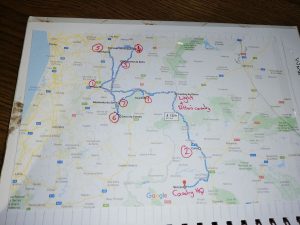 To keep track of where we are, I use Google maps to trace what I know of the routes taken. Most of this is done online as I go along, but occasionally it’s useful to have hard copy to keep referring back to. For example, I’ve printed out a couple of maps and put them in my notebook for book six, showing the location of Wellington’s various divisions through winter quarters. It’s a quick and easy reference tool and stops me making stupid mistakes, such as sending Colonel van Daan to visit the fifth division for a couple of hours when it would actually have taken him a couple of days to get there.
To keep track of where we are, I use Google maps to trace what I know of the routes taken. Most of this is done online as I go along, but occasionally it’s useful to have hard copy to keep referring back to. For example, I’ve printed out a couple of maps and put them in my notebook for book six, showing the location of Wellington’s various divisions through winter quarters. It’s a quick and easy reference tool and stops me making stupid mistakes, such as sending Colonel van Daan to visit the fifth division for a couple of hours when it would actually have taken him a couple of days to get there.
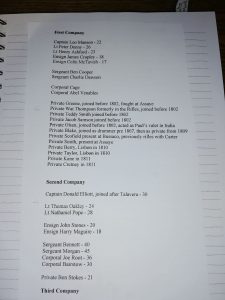 I also keep handy lists in the notebook. At the beginning of each book, I make a new list of my fictional brigade, by battalion and company, and include most of the officers and any significant NCOs and privates. This is a simple word document, which I update when I start a new book, removing anybody who has died, noting promotions and transfers. I then print it out and stick it in the notebook for easy reference. Other lists are specific to each book; I’ve compiled one of Wellington’s staff at HQ since that’s important for this book.
I also keep handy lists in the notebook. At the beginning of each book, I make a new list of my fictional brigade, by battalion and company, and include most of the officers and any significant NCOs and privates. This is a simple word document, which I update when I start a new book, removing anybody who has died, noting promotions and transfers. I then print it out and stick it in the notebook for easy reference. Other lists are specific to each book; I’ve compiled one of Wellington’s staff at HQ since that’s important for this book.
My notebook probably looks chaotic to anybody else, but it’s the basic tool that I work with every day. I started using this method for book four and I love it. I don’t throw the notebooks away when the book is finished, so I have a collection of them now, and they’re quite fun to look through to see how the book developed as I was writing it. More importantly, it stops me writing quick notes on scraps of paper which I then lose. Anything that I need to write down while writing this book goes in that notebook.
Sticky Notes and tags
When I’m first reading up about a campaign, I use a lot of sticky notes and tags to mark pages or sections that are particularly useful. As with notebooks, I much prefer cute tags to plain yellow post it notes, and Sir Charles Oman is currently sporting a fine collection of sea bird tags and Me to You bear post it notes. I’ve got some llama ones that I really like as well. It’s best to be an adult about these things. I don’t make a lot of notes from books, I simply keep the books to hand and refer to them directly as I’m writing.
The End
There’s a magical feeling when the last word is typed, the last edit is done, and the book is finally out there for people to read. One of the great things about writing a series, or even two, is that people are waiting for the books, particularly the Peninsula ones. It can also feel a bit sad. For months, occasionally as long as a year, I’ve lived with these people in my heads every day and now they belong to somebody else. I’ve no control over what people will think of them. Some people will love them, a few won’t, and will say so very vocally in reviews.
There’s a little ritual that I go through once the book is published, clearing my desk. I remove all the tags from the books and put them back on the shelves, I do a final backup of my computer files to make sure and I close my notebook and put it on the shelf with the previous ones. The desk looks empty and very tidy, usually for about twenty-four hours.
Then I get a new notebook out. I always have a stash, I can’t stop buying pretty notebooks. I write the title of the next book on the cover and I put it on my desk. I sit down at my computer and open a new Scrivener file.
And it all begins again.
I hope that “Organised Chaos” gives a little insight into how I work, and answers my reader’s question. I’d be interested to hear how other writers go about organising their work.


 Christmas with Wellington is an excerpt from the next book, An Unmerciful Incursion, which is book six in the
Christmas with Wellington is an excerpt from the next book, An Unmerciful Incursion, which is book six in the 
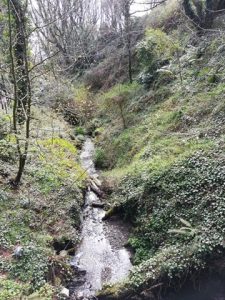 Summerhill Glen #OscarWalks is the first post Oscar and I have done for some time. We’ve been out for walks, of course, but I’ve been away a few times and Oscar had his little operation, which meant we’ve not been out and about around the island as much as we’d have liked. Needless to say, we’re going to be a bit limited for a while, but even close to home, there are some interesting places to go, and one of our favourite places for a daily walk is Summerhill Glen, which is only five minutes from our front door.
Summerhill Glen #OscarWalks is the first post Oscar and I have done for some time. We’ve been out for walks, of course, but I’ve been away a few times and Oscar had his little operation, which meant we’ve not been out and about around the island as much as we’d have liked. Needless to say, we’re going to be a bit limited for a while, but even close to home, there are some interesting places to go, and one of our favourite places for a daily walk is Summerhill Glen, which is only five minutes from our front door. Summerhill Glen has two entrances. The top entrance is on Victoria Road near Governor’s Bridge, and the main entrance is on Summerhill, just up from Douglas Prom. It was apparently originally named Glen Crutchery. The water from the river was used to provide power to a snuff mill on Strathallan Crescent, but the mill burned to the ground in the late eighteenth century. The road became known as Burnt Mill Hill, and then later, Summerhill from a mansion house at the bottom of Blackberry Lane.
Summerhill Glen has two entrances. The top entrance is on Victoria Road near Governor’s Bridge, and the main entrance is on Summerhill, just up from Douglas Prom. It was apparently originally named Glen Crutchery. The water from the river was used to provide power to a snuff mill on Strathallan Crescent, but the mill burned to the ground in the late eighteenth century. The road became known as Burnt Mill Hill, and then later, Summerhill from a mansion house at the bottom of Blackberry Lane. “I didn’t like the Halloween lights, Mum. That dog.”
“I didn’t like the Halloween lights, Mum. That dog.”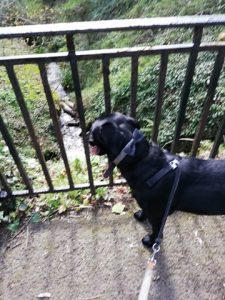 “It’s a waterfall, Oscar.”
“It’s a waterfall, Oscar.” Spring is particularly lovely in the glen, with daffodils and wild flowers forming splashes of colour in the middle of the dense green of the vegetation. The main path is very good, although some of the side paths can get a bit boggy and slippery which can be an issue with an over enthusiastic labrador. Oscar has got so good on the lead now, though, that I don’t have to worry about him.
Spring is particularly lovely in the glen, with daffodils and wild flowers forming splashes of colour in the middle of the dense green of the vegetation. The main path is very good, although some of the side paths can get a bit boggy and slippery which can be an issue with an over enthusiastic labrador. Oscar has got so good on the lead now, though, that I don’t have to worry about him.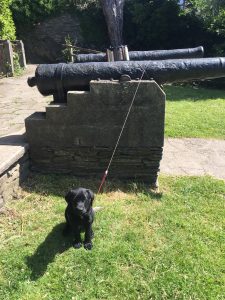

 “Christmas was my favourite, it was like magic. I’m sure some of those lights looked like fairies.”
“Christmas was my favourite, it was like magic. I’m sure some of those lights looked like fairies.”
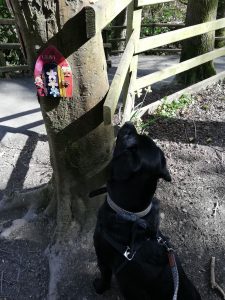

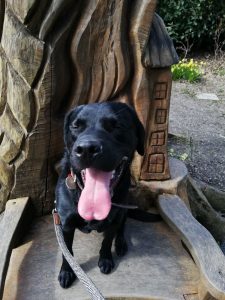
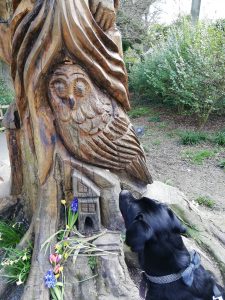
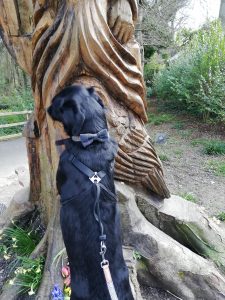

 “Sounds like a plan, Oscar.”
“Sounds like a plan, Oscar.”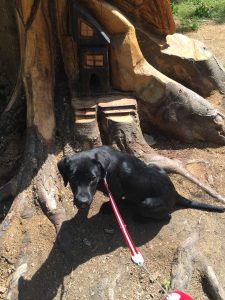
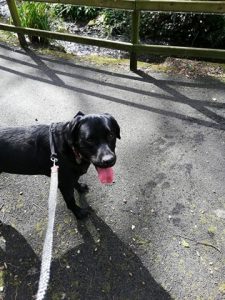

 Generally speaking, my posts tend to be related to history, historical novels or dogs, but given that the world around us has changed so much, so quickly over the past weeks, I thought I’d welcome you all to Social Distancing with Labradors, as Oscar has very definite views on what is going on around here.
Generally speaking, my posts tend to be related to history, historical novels or dogs, but given that the world around us has changed so much, so quickly over the past weeks, I thought I’d welcome you all to Social Distancing with Labradors, as Oscar has very definite views on what is going on around here. And then there is Oscar. Walks are still happening, but we’re staying local and well away from other dog walkers and their pooches. We’re lucky enough to have very large gardens at front and back, so we can play fetch and chasing games. More importantly, there are five people here all the time, to play with him and sit with him and cuddle him. Oscar is doing all right.
And then there is Oscar. Walks are still happening, but we’re staying local and well away from other dog walkers and their pooches. We’re lucky enough to have very large gardens at front and back, so we can play fetch and chasing games. More importantly, there are five people here all the time, to play with him and sit with him and cuddle him. Oscar is doing all right.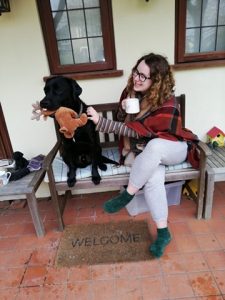 “For me, I mean. I know you all like to go out or go away. But I like it best when you’re all here, with me. The girls haven’t got to go back to that University place for ages, and I get to sit outside with Anya every morning and curl up on the sofa next to Rachael every afternoon. I’m helping her with her work.”
“For me, I mean. I know you all like to go out or go away. But I like it best when you’re all here, with me. The girls haven’t got to go back to that University place for ages, and I get to sit outside with Anya every morning and curl up on the sofa next to Rachael every afternoon. I’m helping her with her work.”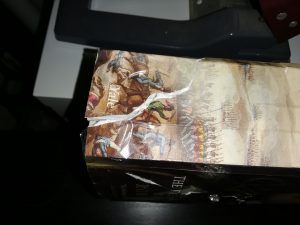 “What about when I eat your books?”
“What about when I eat your books?”
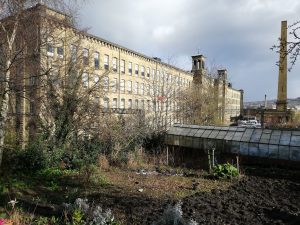
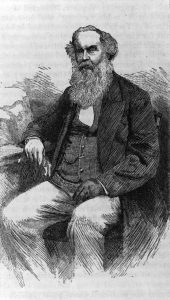 Saltaire was built in 1851 by Sir Titus Salt, a leading industrialist in the Yorkshire woollen industry. Salt was a cloth manufacturer who took over his father’s textile business in 1833 and expanded it over a period of twenty years to be the largest employer in Bradford. He was an alderman and then mayor of Bradford, and was elected to Parliament in 1848. Salt’s business was spread between five different mills, and with business booming, he decided to build a new mill, consolidating his operations into one place.
Saltaire was built in 1851 by Sir Titus Salt, a leading industrialist in the Yorkshire woollen industry. Salt was a cloth manufacturer who took over his father’s textile business in 1833 and expanded it over a period of twenty years to be the largest employer in Bradford. He was an alderman and then mayor of Bradford, and was elected to Parliament in 1848. Salt’s business was spread between five different mills, and with business booming, he decided to build a new mill, consolidating his operations into one place. Salt, a deeply religious man, and a known philanthropist, was concerned about the over-crowded conditions in Bradford so bought land in Shipley, just outside Bradford, beside the River Aire, the Midland Railway and the Leeds and Liverpool Canal. Building began in 1851 and Saltaire Mills opened in 1853. To accommodate his workers, Salt then commissioned housing close to the mill. A model village grew up, which included well-built houses, a hospital, bathhouses, almshouses and churches. The Congregational church, now known as Saltaire United Reformed Church, was built at Salt’s own expense and he donated the land upon which the Wesleyan Chapel was built. With the moral improvement and probably the work performance of his workforce in mind, he forbade public houses or beer shops from the village. The village had a public institute which included a library, a reading room, a concert hall, billiard room, science laboratory and a gym. There was also a village school, a park, allotments and a boathouse.
Salt, a deeply religious man, and a known philanthropist, was concerned about the over-crowded conditions in Bradford so bought land in Shipley, just outside Bradford, beside the River Aire, the Midland Railway and the Leeds and Liverpool Canal. Building began in 1851 and Saltaire Mills opened in 1853. To accommodate his workers, Salt then commissioned housing close to the mill. A model village grew up, which included well-built houses, a hospital, bathhouses, almshouses and churches. The Congregational church, now known as Saltaire United Reformed Church, was built at Salt’s own expense and he donated the land upon which the Wesleyan Chapel was built. With the moral improvement and probably the work performance of his workforce in mind, he forbade public houses or beer shops from the village. The village had a public institute which included a library, a reading room, a concert hall, billiard room, science laboratory and a gym. There was also a village school, a park, allotments and a boathouse. A surprising number of the original buildings survive, including the Institute which is now known as Victoria Hall, and the beautiful United Reformed Church. The houses are lived in and clearly much loved. Modern shops have moved in, and I was particularly entertained by a rather nice looking bar and restaurant, imaginatively called “Don’t Tell Titus” in reference to the founder’s refusal to allow alcohol to be sold anywhere in the village.
A surprising number of the original buildings survive, including the Institute which is now known as Victoria Hall, and the beautiful United Reformed Church. The houses are lived in and clearly much loved. Modern shops have moved in, and I was particularly entertained by a rather nice looking bar and restaurant, imaginatively called “Don’t Tell Titus” in reference to the founder’s refusal to allow alcohol to be sold anywhere in the village.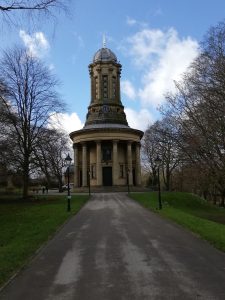

 The Battle of Tenerife, (Comedy Version) was written sitting by a pool in Tenerife last year. For several years, various historian friends and I have occasionally lightened the mood of researching and writing about some of the darker moments of history by writing sketches about how things might really have happened on the day.
The Battle of Tenerife, (Comedy Version) was written sitting by a pool in Tenerife last year. For several years, various historian friends and I have occasionally lightened the mood of researching and writing about some of the darker moments of history by writing sketches about how things might really have happened on the day.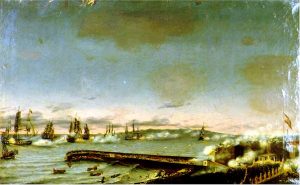
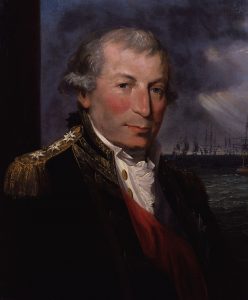 Admiral Jervis is still celebrating his memorable victory at Cape St Vincent. He’s also a bit cross about Cadiz not working out quite so well and those pesky Spanish whizzing treasure ships around right under his nose. The sailors are getting restive. The Admiral is feeling the pressure. It’s Saturday night, a few drinks in the Admiral’s dining cabin and Jervis has had enough…
Admiral Jervis is still celebrating his memorable victory at Cape St Vincent. He’s also a bit cross about Cadiz not working out quite so well and those pesky Spanish whizzing treasure ships around right under his nose. The sailors are getting restive. The Admiral is feeling the pressure. It’s Saturday night, a few drinks in the Admiral’s dining cabin and Jervis has had enough…
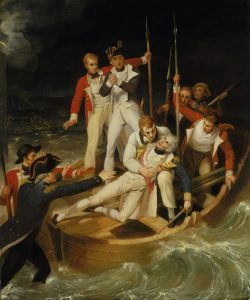 Some time later, somewhere in England, debriefing meeting
Some time later, somewhere in England, debriefing meeting
 Good weather gave us the chance for a beautiful walk in the south of the island. Oscar was on the lead for most of the way, but was able to have a couple of off-lead runs which he loves. I have to tell you in advance that he was a VERY GOOD BOY today.
Good weather gave us the chance for a beautiful walk in the south of the island. Oscar was on the lead for most of the way, but was able to have a couple of off-lead runs which he loves. I have to tell you in advance that he was a VERY GOOD BOY today.

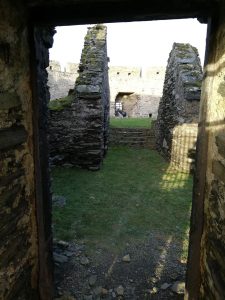
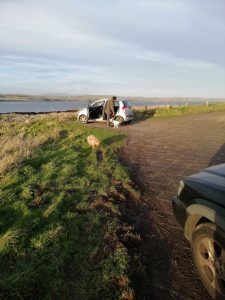 “Whew, that was fun. They’re not youngsters, those two, but they could run. Although that one waddled a bit like old Joey. Where now?”
“Whew, that was fun. They’re not youngsters, those two, but they could run. Although that one waddled a bit like old Joey. Where now?” “Ruined. No, that’s King William’s College. It’s the only public school on the island. Which really means it’s a private school, because you have to pay to go there. I’ve never really understood that.”
“Ruined. No, that’s King William’s College. It’s the only public school on the island. Which really means it’s a private school, because you have to pay to go there. I’ve never really understood that.” “Can I go on the beach?”
“Can I go on the beach?”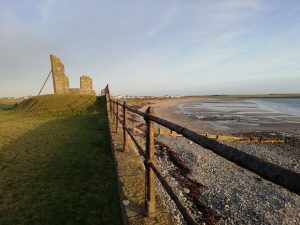 “Ooh. What’s that?”
“Ooh. What’s that?”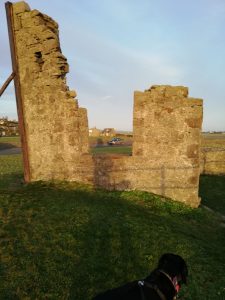 Hango Hill is a small mound by the side of the coast road between Castletown and Derbyhaven, overlooking the beach. It was possibly an ancient burial site and a Bronze Age flat axe was apparently discovered there. The name derives from the Norse words for Gallows Hill and was used as a place of execution until the seventeenth or possibly early eighteenth century.
Hango Hill is a small mound by the side of the coast road between Castletown and Derbyhaven, overlooking the beach. It was possibly an ancient burial site and a Bronze Age flat axe was apparently discovered there. The name derives from the Norse words for Gallows Hill and was used as a place of execution until the seventeenth or possibly early eighteenth century.

 “It’s just a little bit about the history of the place and Illiam Dhone. Each year, on the anniversary of his death, they have a gathering here and make a speech in the Manx language.”
“It’s just a little bit about the history of the place and Illiam Dhone. Each year, on the anniversary of his death, they have a gathering here and make a speech in the Manx language.” “It is. The light’s starting to fade as well, I forget how early it gets dark. Right, back to the car then, we’ll be warmer if we’re walking.”
“It is. The light’s starting to fade as well, I forget how early it gets dark. Right, back to the car then, we’ll be warmer if we’re walking.”

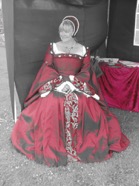
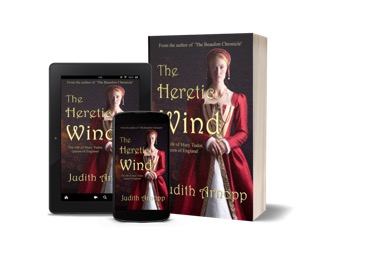


 Iris Bryant would have been 89 today.
Iris Bryant would have been 89 today. 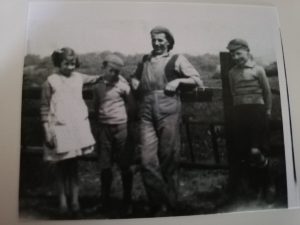

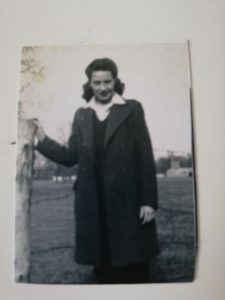
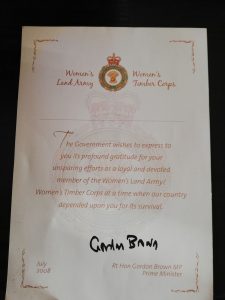 Mum had very happy memories of her Land Army days near Cambridge and we loved her stories when we were children. The women’s land army finally received a veterans’ badge and acknowledgement for their service in 2007. I can’t tell you what Mum said about that, but she was actually very proud of it. I still have the badge she wore at the time. Mum’s stories made even the worst tasks sound like a laugh and talked fondly of dances at the local American and Canadian air bases. She had several boyfriends during those years, light-hearted romances with a Canadian pilot and an Irishman from an army base, called Paddy, but then towards the end of her time there, she met Kurt, a former German POW who had chosen to remain in the area after the war, working on a farm. Kurt was different, it was serious, and for a time I think she genuinely thought she might marry him, but the prospect of him possibly wanting to move back to Germany one day made her hesitate.
Mum had very happy memories of her Land Army days near Cambridge and we loved her stories when we were children. The women’s land army finally received a veterans’ badge and acknowledgement for their service in 2007. I can’t tell you what Mum said about that, but she was actually very proud of it. I still have the badge she wore at the time. Mum’s stories made even the worst tasks sound like a laugh and talked fondly of dances at the local American and Canadian air bases. She had several boyfriends during those years, light-hearted romances with a Canadian pilot and an Irishman from an army base, called Paddy, but then towards the end of her time there, she met Kurt, a former German POW who had chosen to remain in the area after the war, working on a farm. Kurt was different, it was serious, and for a time I think she genuinely thought she might marry him, but the prospect of him possibly wanting to move back to Germany one day made her hesitate.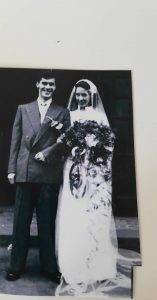 At some point, he must have decided that it was decision making time. I’ve never known how that was worked out, but Mum went up to Cambridge to talk to Kurt and promised my Dad that she’d give him a definite answer on the Sunday evening when she got back. The ensuing story is a family legend, with something farcical about it which could never happen in these days of mobile phones and messaging. Mum’s train was delayed and she missed their rendezvous which led Dad to think she’d decided to marry Kurt. He went home, miserable, but then decided he still wanted to speak to her so went back out and got the underground to her house. She, meanwhile, got the underground to his house, only to find he wasn’t there. In their mutual upset, it took two more cross London train journeys before they finally managed to meet up. They were married in 1952 on Christmas Day.
At some point, he must have decided that it was decision making time. I’ve never known how that was worked out, but Mum went up to Cambridge to talk to Kurt and promised my Dad that she’d give him a definite answer on the Sunday evening when she got back. The ensuing story is a family legend, with something farcical about it which could never happen in these days of mobile phones and messaging. Mum’s train was delayed and she missed their rendezvous which led Dad to think she’d decided to marry Kurt. He went home, miserable, but then decided he still wanted to speak to her so went back out and got the underground to her house. She, meanwhile, got the underground to his house, only to find he wasn’t there. In their mutual upset, it took two more cross London train journeys before they finally managed to meet up. They were married in 1952 on Christmas Day.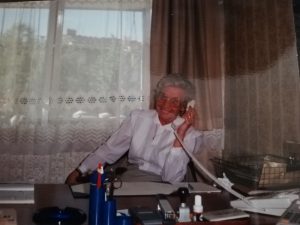

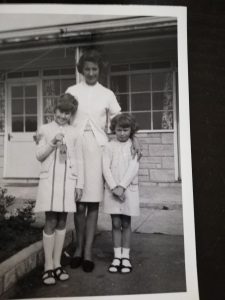
 Happy Birthday to Iris Bryant, nee Taylor, an East End girl to the end of her days. I’ll go up in a bit and put daffodils on the grave, they were your favourite flower and both your grand daughter and I love them just as much. You’re laughing somewhere at me doing that, telling me not to be daft, to take the flowers home and enjoy them myself. I’ll get some for me as well. I always do on this day.
Happy Birthday to Iris Bryant, nee Taylor, an East End girl to the end of her days. I’ll go up in a bit and put daffodils on the grave, they were your favourite flower and both your grand daughter and I love them just as much. You’re laughing somewhere at me doing that, telling me not to be daft, to take the flowers home and enjoy them myself. I’ll get some for me as well. I always do on this day.